Analysis of Globalisation, Cultural Differences, and Hofstede's Model
VerifiedAdded on 2024/07/22
|7
|1195
|223
Report
AI Summary
This report provides an analysis of globalisation, cultural differences, and the application of Hofstede's cultural dimensions. The report begins with an executive summary and includes two e-learning activities. The first activity explores Professor Pankaj Ghemawat's perspective on globalisation, discussing its complexities, challenges, and potential fears. The second activity examines cultural differences through an online tool, using Hofstede's model to compare countries like Australia, India, and Thailand, highlighting variations in cultural values and societal norms. The report concludes by summarizing the various facets of globalisation and the diverse cultural landscapes across different nations. The report also includes references to academic sources that support the analysis.

Research Paper 1
Paraphrase This Document
Need a fresh take? Get an instant paraphrase of this document with our AI Paraphraser

Table of Contents
Executive Summary................................................................................................................................. 3
E-learning Activities................................................................................................................................ 3
Week- 2 – Activity- 2 – Pankaj Ghemawat on Globalisation..............................................................3
Week- 2 – Activity- 3 – Online tool to explore different countries' 5 dimensions by Hofstede.........5
Conclusion............................................................................................................................................... 6
References................................................................................................................................................7
Executive Summary................................................................................................................................. 3
E-learning Activities................................................................................................................................ 3
Week- 2 – Activity- 2 – Pankaj Ghemawat on Globalisation..............................................................3
Week- 2 – Activity- 3 – Online tool to explore different countries' 5 dimensions by Hofstede.........5
Conclusion............................................................................................................................................... 6
References................................................................................................................................................7
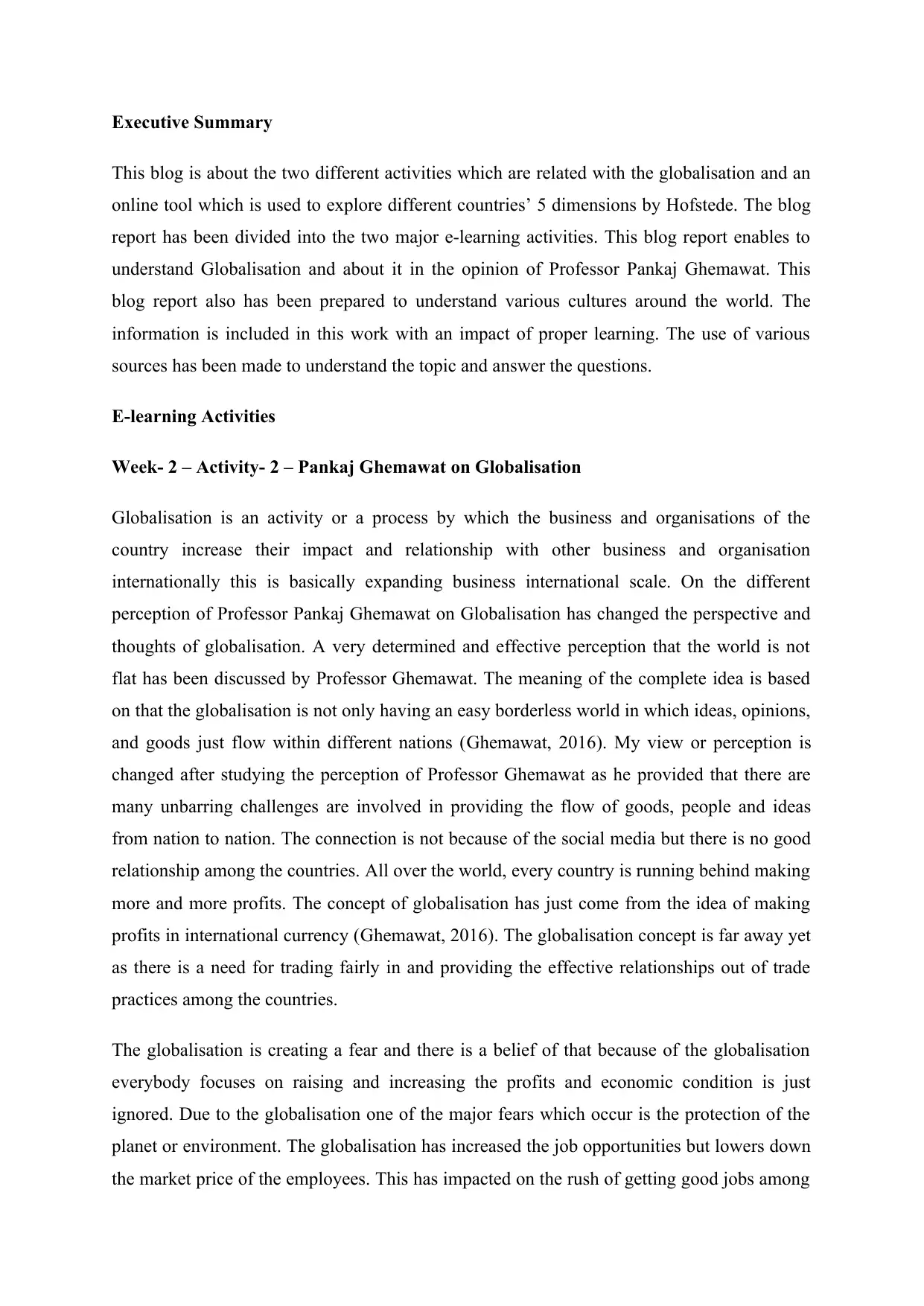
Executive Summary
This blog is about the two different activities which are related with the globalisation and an
online tool which is used to explore different countries’ 5 dimensions by Hofstede. The blog
report has been divided into the two major e-learning activities. This blog report enables to
understand Globalisation and about it in the opinion of Professor Pankaj Ghemawat. This
blog report also has been prepared to understand various cultures around the world. The
information is included in this work with an impact of proper learning. The use of various
sources has been made to understand the topic and answer the questions.
E-learning Activities
Week- 2 – Activity- 2 – Pankaj Ghemawat on Globalisation
Globalisation is an activity or a process by which the business and organisations of the
country increase their impact and relationship with other business and organisation
internationally this is basically expanding business international scale. On the different
perception of Professor Pankaj Ghemawat on Globalisation has changed the perspective and
thoughts of globalisation. A very determined and effective perception that the world is not
flat has been discussed by Professor Ghemawat. The meaning of the complete idea is based
on that the globalisation is not only having an easy borderless world in which ideas, opinions,
and goods just flow within different nations (Ghemawat, 2016). My view or perception is
changed after studying the perception of Professor Ghemawat as he provided that there are
many unbarring challenges are involved in providing the flow of goods, people and ideas
from nation to nation. The connection is not because of the social media but there is no good
relationship among the countries. All over the world, every country is running behind making
more and more profits. The concept of globalisation has just come from the idea of making
profits in international currency (Ghemawat, 2016). The globalisation concept is far away yet
as there is a need for trading fairly in and providing the effective relationships out of trade
practices among the countries.
The globalisation is creating a fear and there is a belief of that because of the globalisation
everybody focuses on raising and increasing the profits and economic condition is just
ignored. Due to the globalisation one of the major fears which occur is the protection of the
planet or environment. The globalisation has increased the job opportunities but lowers down
the market price of the employees. This has impacted on the rush of getting good jobs among
This blog is about the two different activities which are related with the globalisation and an
online tool which is used to explore different countries’ 5 dimensions by Hofstede. The blog
report has been divided into the two major e-learning activities. This blog report enables to
understand Globalisation and about it in the opinion of Professor Pankaj Ghemawat. This
blog report also has been prepared to understand various cultures around the world. The
information is included in this work with an impact of proper learning. The use of various
sources has been made to understand the topic and answer the questions.
E-learning Activities
Week- 2 – Activity- 2 – Pankaj Ghemawat on Globalisation
Globalisation is an activity or a process by which the business and organisations of the
country increase their impact and relationship with other business and organisation
internationally this is basically expanding business international scale. On the different
perception of Professor Pankaj Ghemawat on Globalisation has changed the perspective and
thoughts of globalisation. A very determined and effective perception that the world is not
flat has been discussed by Professor Ghemawat. The meaning of the complete idea is based
on that the globalisation is not only having an easy borderless world in which ideas, opinions,
and goods just flow within different nations (Ghemawat, 2016). My view or perception is
changed after studying the perception of Professor Ghemawat as he provided that there are
many unbarring challenges are involved in providing the flow of goods, people and ideas
from nation to nation. The connection is not because of the social media but there is no good
relationship among the countries. All over the world, every country is running behind making
more and more profits. The concept of globalisation has just come from the idea of making
profits in international currency (Ghemawat, 2016). The globalisation concept is far away yet
as there is a need for trading fairly in and providing the effective relationships out of trade
practices among the countries.
The globalisation is creating a fear and there is a belief of that because of the globalisation
everybody focuses on raising and increasing the profits and economic condition is just
ignored. Due to the globalisation one of the major fears which occur is the protection of the
planet or environment. The globalisation has increased the job opportunities but lowers down
the market price of the employees. This has impacted on the rush of getting good jobs among
⊘ This is a preview!⊘
Do you want full access?
Subscribe today to unlock all pages.

Trusted by 1+ million students worldwide
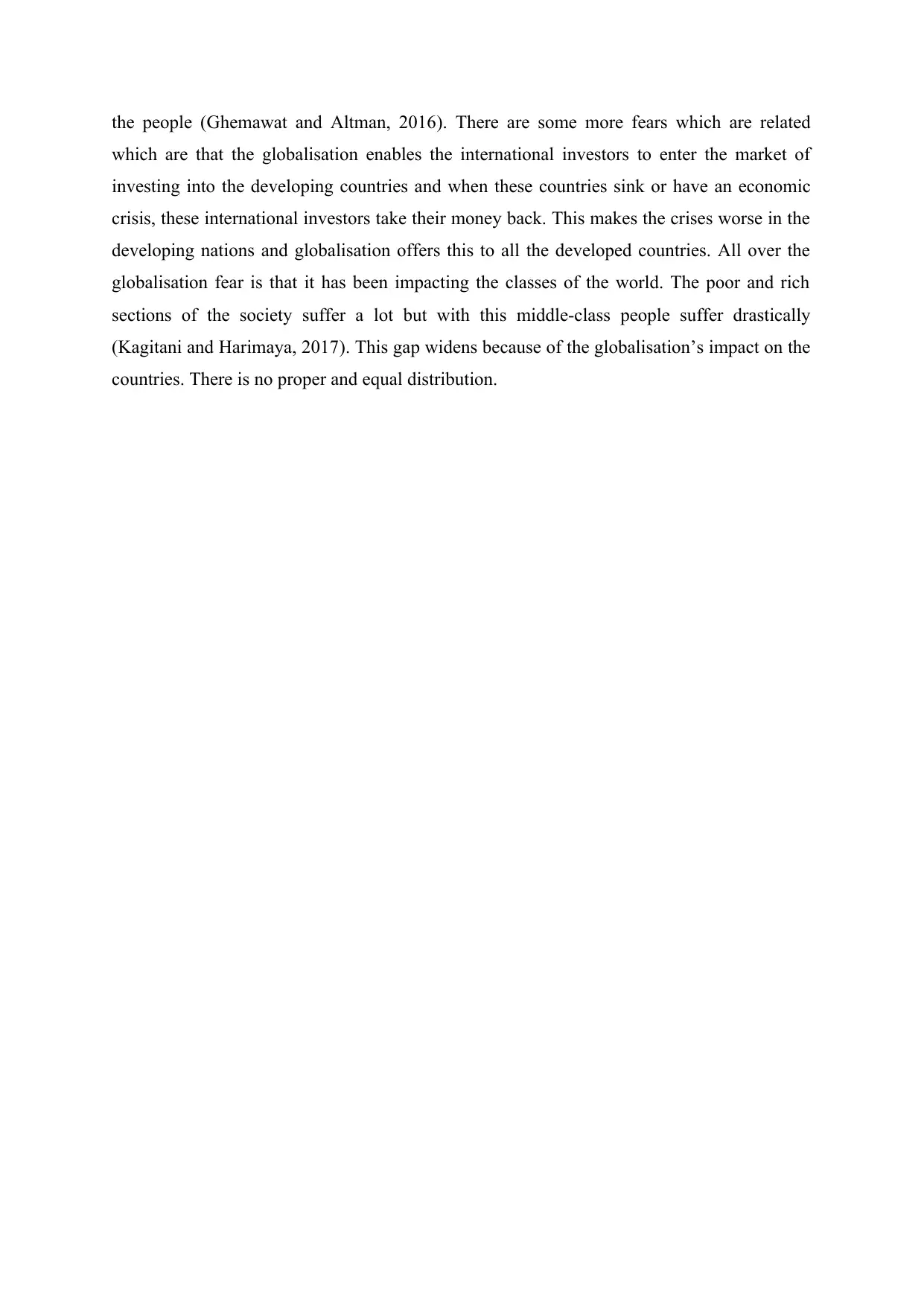
the people (Ghemawat and Altman, 2016). There are some more fears which are related
which are that the globalisation enables the international investors to enter the market of
investing into the developing countries and when these countries sink or have an economic
crisis, these international investors take their money back. This makes the crises worse in the
developing nations and globalisation offers this to all the developed countries. All over the
globalisation fear is that it has been impacting the classes of the world. The poor and rich
sections of the society suffer a lot but with this middle-class people suffer drastically
(Kagitani and Harimaya, 2017). This gap widens because of the globalisation’s impact on the
countries. There is no proper and equal distribution.
which are that the globalisation enables the international investors to enter the market of
investing into the developing countries and when these countries sink or have an economic
crisis, these international investors take their money back. This makes the crises worse in the
developing nations and globalisation offers this to all the developed countries. All over the
globalisation fear is that it has been impacting the classes of the world. The poor and rich
sections of the society suffer a lot but with this middle-class people suffer drastically
(Kagitani and Harimaya, 2017). This gap widens because of the globalisation’s impact on the
countries. There is no proper and equal distribution.
Paraphrase This Document
Need a fresh take? Get an instant paraphrase of this document with our AI Paraphraser
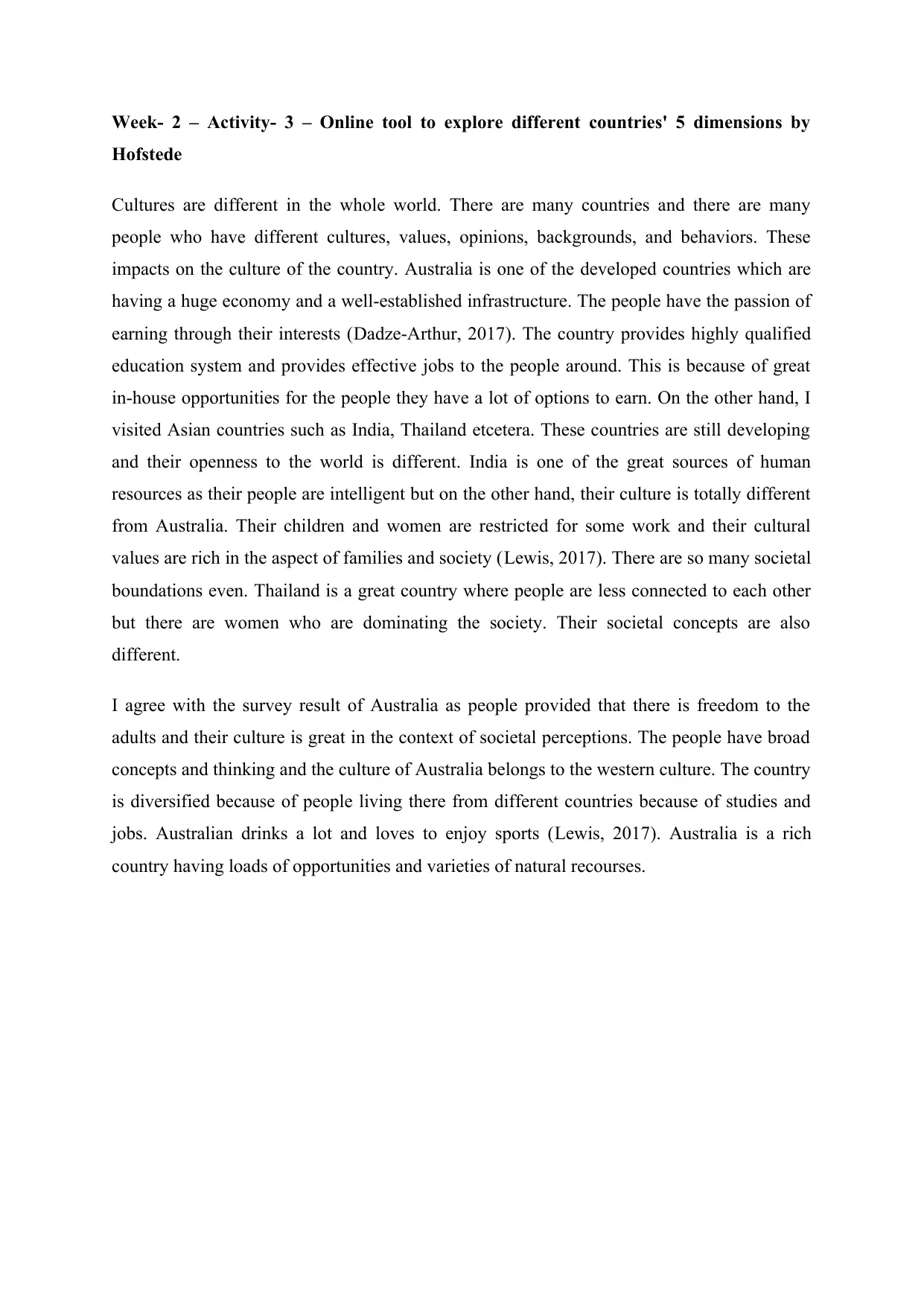
Week- 2 – Activity- 3 – Online tool to explore different countries' 5 dimensions by
Hofstede
Cultures are different in the whole world. There are many countries and there are many
people who have different cultures, values, opinions, backgrounds, and behaviors. These
impacts on the culture of the country. Australia is one of the developed countries which are
having a huge economy and a well-established infrastructure. The people have the passion of
earning through their interests (Dadze-Arthur, 2017). The country provides highly qualified
education system and provides effective jobs to the people around. This is because of great
in-house opportunities for the people they have a lot of options to earn. On the other hand, I
visited Asian countries such as India, Thailand etcetera. These countries are still developing
and their openness to the world is different. India is one of the great sources of human
resources as their people are intelligent but on the other hand, their culture is totally different
from Australia. Their children and women are restricted for some work and their cultural
values are rich in the aspect of families and society (Lewis, 2017). There are so many societal
boundations even. Thailand is a great country where people are less connected to each other
but there are women who are dominating the society. Their societal concepts are also
different.
I agree with the survey result of Australia as people provided that there is freedom to the
adults and their culture is great in the context of societal perceptions. The people have broad
concepts and thinking and the culture of Australia belongs to the western culture. The country
is diversified because of people living there from different countries because of studies and
jobs. Australian drinks a lot and loves to enjoy sports (Lewis, 2017). Australia is a rich
country having loads of opportunities and varieties of natural recourses.
Hofstede
Cultures are different in the whole world. There are many countries and there are many
people who have different cultures, values, opinions, backgrounds, and behaviors. These
impacts on the culture of the country. Australia is one of the developed countries which are
having a huge economy and a well-established infrastructure. The people have the passion of
earning through their interests (Dadze-Arthur, 2017). The country provides highly qualified
education system and provides effective jobs to the people around. This is because of great
in-house opportunities for the people they have a lot of options to earn. On the other hand, I
visited Asian countries such as India, Thailand etcetera. These countries are still developing
and their openness to the world is different. India is one of the great sources of human
resources as their people are intelligent but on the other hand, their culture is totally different
from Australia. Their children and women are restricted for some work and their cultural
values are rich in the aspect of families and society (Lewis, 2017). There are so many societal
boundations even. Thailand is a great country where people are less connected to each other
but there are women who are dominating the society. Their societal concepts are also
different.
I agree with the survey result of Australia as people provided that there is freedom to the
adults and their culture is great in the context of societal perceptions. The people have broad
concepts and thinking and the culture of Australia belongs to the western culture. The country
is diversified because of people living there from different countries because of studies and
jobs. Australian drinks a lot and loves to enjoy sports (Lewis, 2017). Australia is a rich
country having loads of opportunities and varieties of natural recourses.
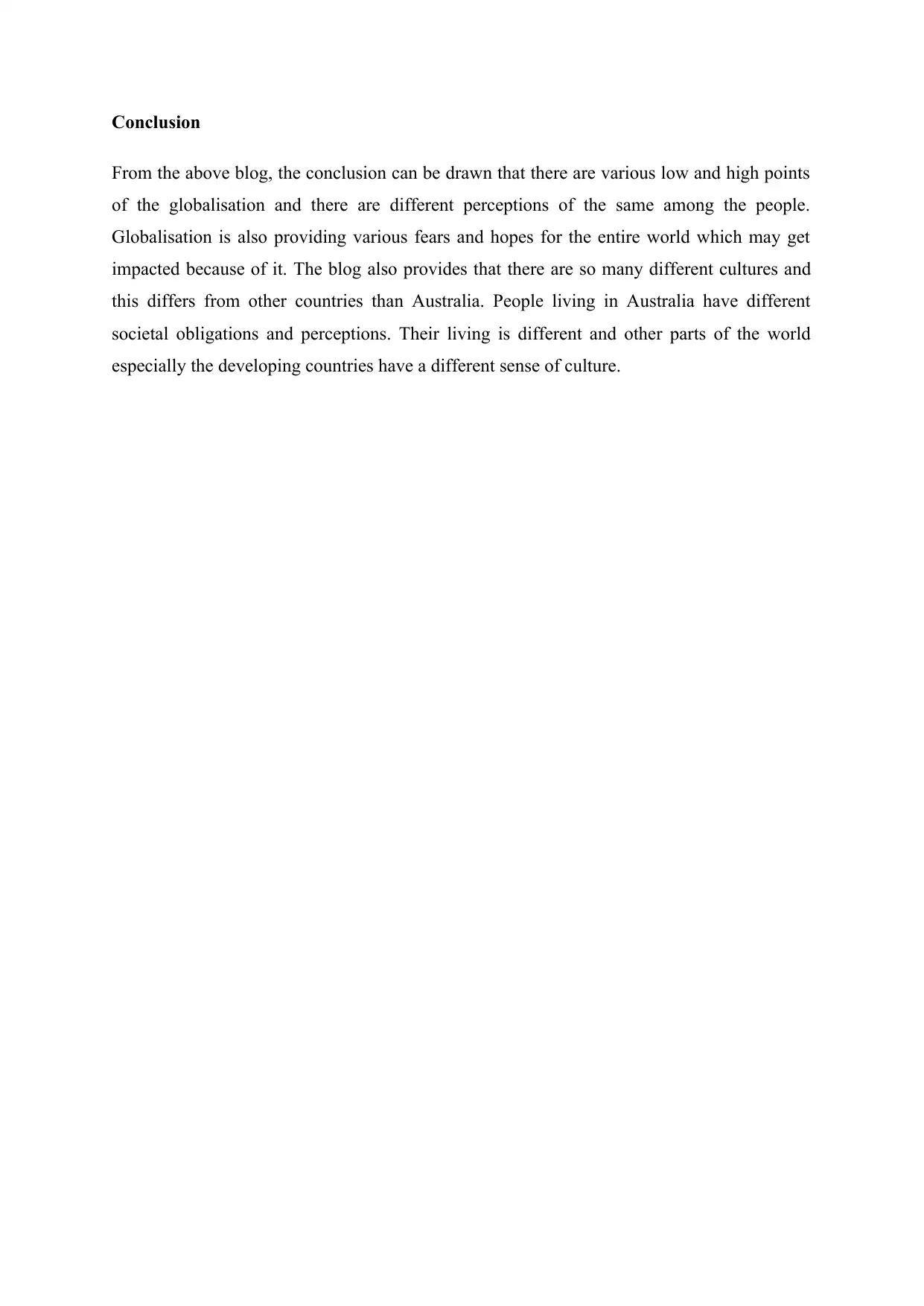
Conclusion
From the above blog, the conclusion can be drawn that there are various low and high points
of the globalisation and there are different perceptions of the same among the people.
Globalisation is also providing various fears and hopes for the entire world which may get
impacted because of it. The blog also provides that there are so many different cultures and
this differs from other countries than Australia. People living in Australia have different
societal obligations and perceptions. Their living is different and other parts of the world
especially the developing countries have a different sense of culture.
From the above blog, the conclusion can be drawn that there are various low and high points
of the globalisation and there are different perceptions of the same among the people.
Globalisation is also providing various fears and hopes for the entire world which may get
impacted because of it. The blog also provides that there are so many different cultures and
this differs from other countries than Australia. People living in Australia have different
societal obligations and perceptions. Their living is different and other parts of the world
especially the developing countries have a different sense of culture.
⊘ This is a preview!⊘
Do you want full access?
Subscribe today to unlock all pages.

Trusted by 1+ million students worldwide
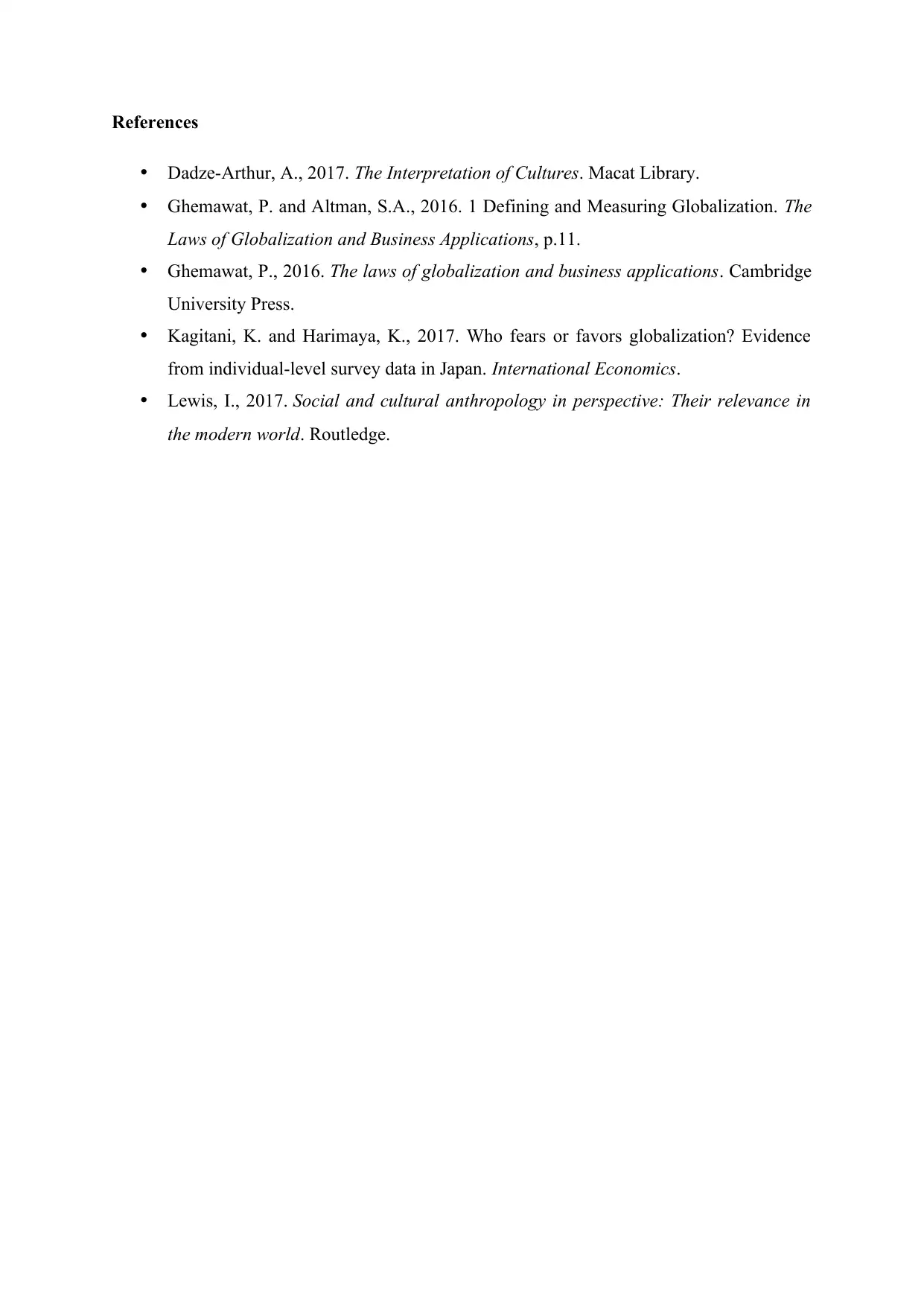
References
Dadze-Arthur, A., 2017. The Interpretation of Cultures. Macat Library.
Ghemawat, P. and Altman, S.A., 2016. 1 Defining and Measuring Globalization. The
Laws of Globalization and Business Applications, p.11.
Ghemawat, P., 2016. The laws of globalization and business applications. Cambridge
University Press.
Kagitani, K. and Harimaya, K., 2017. Who fears or favors globalization? Evidence
from individual-level survey data in Japan. International Economics.
Lewis, I., 2017. Social and cultural anthropology in perspective: Their relevance in
the modern world. Routledge.
Dadze-Arthur, A., 2017. The Interpretation of Cultures. Macat Library.
Ghemawat, P. and Altman, S.A., 2016. 1 Defining and Measuring Globalization. The
Laws of Globalization and Business Applications, p.11.
Ghemawat, P., 2016. The laws of globalization and business applications. Cambridge
University Press.
Kagitani, K. and Harimaya, K., 2017. Who fears or favors globalization? Evidence
from individual-level survey data in Japan. International Economics.
Lewis, I., 2017. Social and cultural anthropology in perspective: Their relevance in
the modern world. Routledge.
1 out of 7
Related Documents
Your All-in-One AI-Powered Toolkit for Academic Success.
+13062052269
info@desklib.com
Available 24*7 on WhatsApp / Email
![[object Object]](/_next/static/media/star-bottom.7253800d.svg)
Unlock your academic potential
Copyright © 2020–2025 A2Z Services. All Rights Reserved. Developed and managed by ZUCOL.





